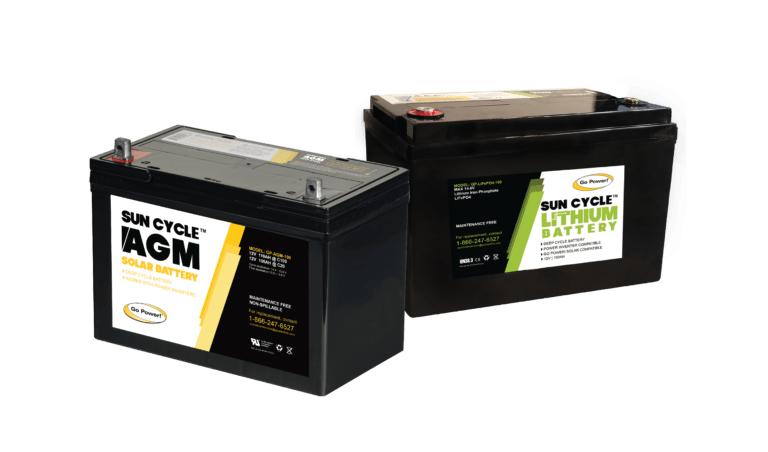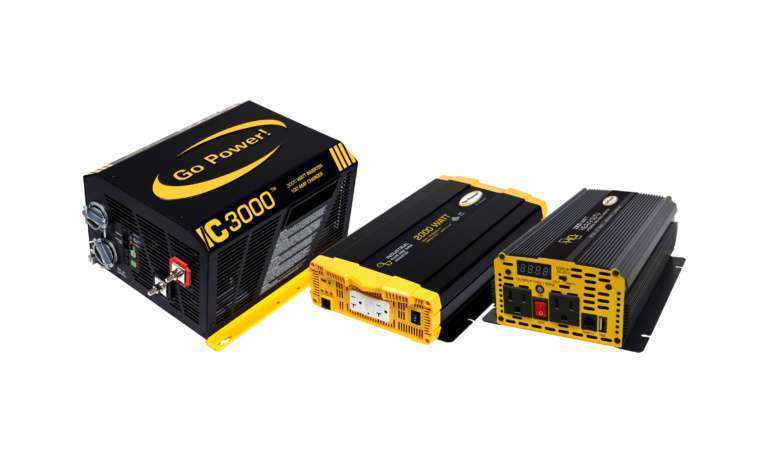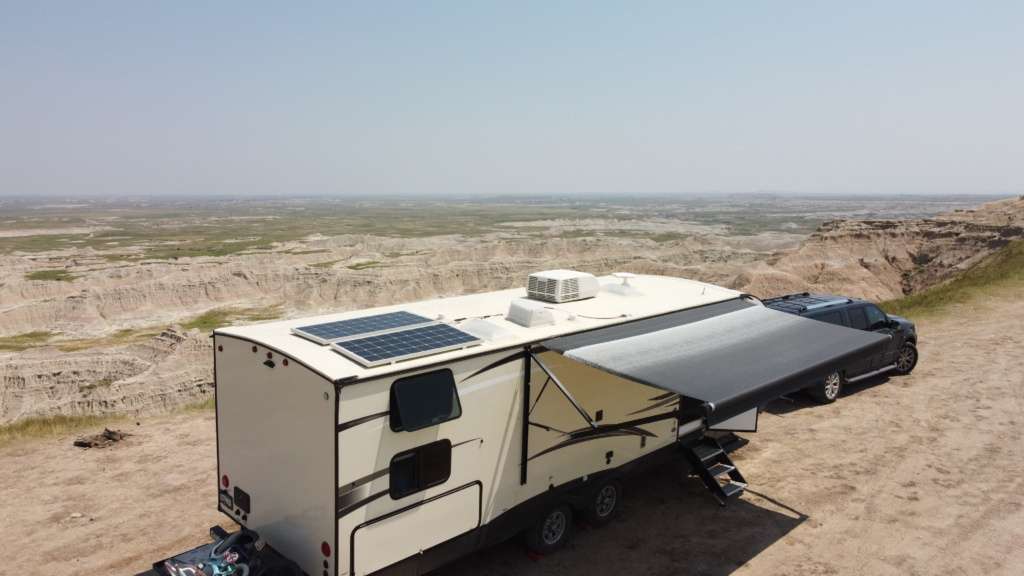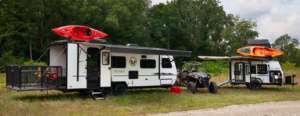Go further off the grid with the new No Boundaries travel trailer with Beast Mode...
Read MoreThe Ultimate RV Solar Maintenance Guide - Solar Bliss on Wheels
Table of Contents
Buckle up, adventurers! In the realm of RV travel, where the open road meets the great outdoors, there's a silent powerhouse steering the way—your RV solar system. Solar power has been a great enabler of living the off-grid lifestyle, delivering cost-effective, renewable energy. No wonder many RVers are already relying on the sun’s relentless power supply, providing them with convenience and independence on their road trips.
As we dive into the heart of RV solar maintenance, envision your solar system optimized for peak performance. This guide is your ticket to unlocking the full potential of solar bliss on wheels. Let's dive in and discover the secrets to keeping your RV solar system soaring.
How does RV solar work?
Let’s have a quick look at the components of an RV solar system and how they work together to provide your vehicle with energy.
Ensuring optimal RV solar performance
Fortunately, RV solar systems require only minimal maintenance. But consistent care and occasional upgrades ensure that you have power when you need it most. A proactive approach not only helps prevent power outages but also extends the lifespan of your hardware, ensuring you get the maximum output.
When it comes to the health and efficiency of your RV solar system, regular checks and inspections are paramount. This section outlines essential steps to incorporate into your routine to ensure everything is in top-notch condition.
1. Daily System Glance
- Monitoring: Daily checks of battery levels provide insights into your power reserve. Use available monitoring tools or software to track panel performance. Familiarizing yourself with your RV's monitoring system helps to detect any anomalies that might indicate maintenance needs. Smart mobile power systems like PowerTrak™ are setting new standards in RV solar monitoring.
- Visual Inspection: A quick visual inspection of the solar panel array ensures there are no noticeable damages, shading issues, or foreign objects obstructing sunlight absorption.
2. Monthly System Scrutiny
- Panel Examination: Inspect solar panels monthly for signs of dirt, bird droppings, or debris. Clean panels as needed to maintain peak performance.
- Wiring and Connection Check: Examine all wiring for wear or damage. Ensure that connections are tight and free from corrosion, providing seamless energy flow.
3. Annual Deep Dive
- Comprehensive Cleaning: Conduct a thorough cleaning of solar panels to remove accumulated grime. This is also an excellent time to inspect for any wear or potential issues.
- Battery Health Check: Run a comprehensive check on your batteries, examining for signs of corrosion, leaks, or physical damage. Perform a capacity test to ensure your batteries can hold a charge and deliver power consistently.
In addition to the above, you may want to consider the occasional professional inspection. Have an expert evaluate the system every few years, assessing the overall condition of your solar system and ensuring it is functioning optimally. Professionals can identify any potential issues and perform maintenance tasks that require specialized expertise.
Cleaning and maintaining RV solar panels
The solar panels are your sleek energy harvesters transforming sunlight into power for your RV. To keep them operating at peak efficiency, a bit of TLC is in order. Over time, dust, sand, and debris can impact the efficiency of your solar setup.
How do I clean my solar panels?
Choosing a Go Power Solar RV Kit helps to keep maintenance at a minimum. However, you can benefit from performance gains by regularly cleaning the solar panels. How often you will need to clean them depends on the circumstances. The reality is that wind will blow off loose particles and dust, so when driving, there is an inherent cleaning effect. The same applies to rain; it washes down the panels, rinsing away dirt that may have built up.
Step-by-step guide for cleaning your solar panels
1. Turning off the system is only required if you disconnect any of the wiring.
2. Clean the solar panels as needed on a bi-annual or monthly basis. Use water and a soft sponge or cloth. A mild, non-abrasive cleanser can be used for more stubborn residue. Rinse well.
3. You may have to clean the panels more frequently during drier months. A pressure washer is not recommended.
4. Use a soft brush to remove snow during the cold months to keep producing power.
5. Clean seasonal substances like pollen or leaves and other tree droppings that may get stuck on the panels.
6. Watch out for bird droppings and clean them off as soon as possible.
7. Check all wire connections to ensure all are still securely attached.
Do flexible panels require different care?
The surface of flexible panels is more delicate than that of rigid panels. It’s advisable to proceed without applying much force. The panels should be cleaned using soap and water, wiping carefully and without using abrasive materials. Do not use scouring pads or other materials that could scrape the surface. Rubbing alcohol can be used to remove tougher grease, sap, etc. Whenever in doubt, consult the manufacturer's recommendations for cleaning and maintenance to comply with warranty provisions.
Solar panel maintenance – Tips for being proactive
Solar panel care extends beyond cleaning. The structural integrity of the installation and the electrical connections will need to be checked periodically. Are there any cracks, missing or broken hardware, or other potential problems?
- Check all roof penetrations and replace sealant as required
- Make sure mounting hardware is securely fastened to the vehicle and panels
- Watch for any connections that may have come loose due to vibrations
By implementing these cleaning and maintenance practices, you'll ensure that your solar panels continue to harvest the sun's energy efficiently, providing sustainable power for your RV adventures.

Battery maintenance – Peak performance and extended lifespan
Routine inspections also help with preserving the longevity of RV batteries. Keep an eye out for any indications of corrosion or leaks, and verify that the connections remain clean and securely tightened. Regular monitoring of your batteries’ charge level and voltage will help to detect any potential issues ahead of time.
Watch out for differences between battery types
Lead Acid batteries are likely the stock batteries your RV or trailer came with. Lead acid batteries are the most inexpensive batteries on the market today. They require a vented location, regular maintenance, and are one of the older battery technologies available.
AGM batteries are sealed, do not spill or vent gas, and require very little maintenance. AGM batteries also charge quickly and are more resistant to low temperatures. They are, however, sensitive to overcharging.
Lithium batteries require virtually no maintenance. Advanced Lithium batteries will come with an integrated battery management system. Even though the high performance and long lifecycle come with a higher price tag, many RVers are in love with this type of battery.
Comprehensive battery maintenance checklist
1. Regular Inspections: Conduct routine checks of your batteries to detect any signs of corrosion, leaks, or physical damage.
2. Terminal Maintenance: Ensure that the connections at the terminals are securely tightened. Use a solution of baking soda and water or a wire brush to clean any corrosion. Disconnect the cables, clean the terminals and cable ends, and then reconnect them.
3. Voltage Monitoring: Consistently monitor the voltage of your batteries with a multimeter. This practice helps in identifying potential issues with either the charging system or the batteries themselves. Periodically, perform a capacity test to ascertain the batteries' ability to hold a charge.
4. Charging Best Practices: Regularly charge your batteries, especially if the vehicle is not in use. Consider investing in a battery maintainer to sustain optimal charge levels during periods of storage.
5. Water Level Check (for Lead-Acid Batteries): If you use lead-acid batteries, routinely inspect water levels. Add distilled water as necessary.
6. Timely Replacement: Recognize that batteries have a finite lifespan. If you observe a significant decline in performance or if your batteries are aging, contemplate replacing them.
7. Professional Evaluation: If you are not sure about the condition of your batteries or if an issue persists, seek out a professional service technician for a comprehensive inspection.
Regular checks and consistent maintenance can dramatically extend battery life, in many cases, by 4-5 years. Solar power is a great way to frequently recharge your batteries and contribute to their health.

Inverter and charge controller maintenance
Charge Controllers manage the charging process of your van’s batteries. As an electronic device, they should only require minimal maintenance, often limited to accumulated dust or dirt. They generate heat during operation, so adequate air circulation is required.
Regularly check for software updates with bug fixes and improved functionality to keep your charge controller humming and your batteries safe.
Inverters transform DC from the batteries into AC power. Follow these recommendations for improved efficiency:
1. Check for loose connections, signs of overheating, or physical damage to the inverter.
2. Clean dust and debris to avoid blocked vents, as those cause overheating and reduce efficiency.
3. Make sure there are no obstructions to inverters with cooling fans. A well-ventilated inverter works better and lasts longer.
4. Regularly test the overload protection mechanisms of the inverter to ensure it shuts down safely. Check and test any alarm systems or warning indicators on the inverter for continued safe operation.

System health in extreme temperatures
In extremely hot weather, components can overheat, with a detrimental effect on performance. Ensure airflow around the solar panels and keep the batteries well ventilated and in the shade. It may be necessary to open access panels to keep the inverter cool.
For winterizing, proceed as follows:
- If you are removing the batteries for storage, then cover the solar panels with something opaque. Once in the dark, they are powered off and will wait patiently until they are uncovered in the spring after the batteries are re-installed.
- If you have lead, AGM, or heated Lithium batteries and are not removing them from the vehicle, then leave the solar system in place and simply ensure the panels are not covered in snow. If you have non-heated lithium batteries (and are in a place that drops below freezing for an extended period), fully charge and disconnect them. Preferably store them inside, away from extreme cold.
Visit our Support Center for any questions related to the maintenance of your RV solar system.
LATEST NEWS
Watch product troubleshooting videos, read the latest in company updates, and stay up-to-date on trade-shows and events.
New Eclipse MPPT Solar Charging
NEW PRODUCT ALERT – available soon at an RV dealer near you! We are pleased...
Read MoreGo Power! Supports “Drab to
GO POWER! SUPPORTS “DRAB TO FAB” PROJECT WITH RV WOMEN’S ALLIANCE How often does a...
Read More
Download the RV Solar Resource Guide
Download the RV Solar Resource Guide




